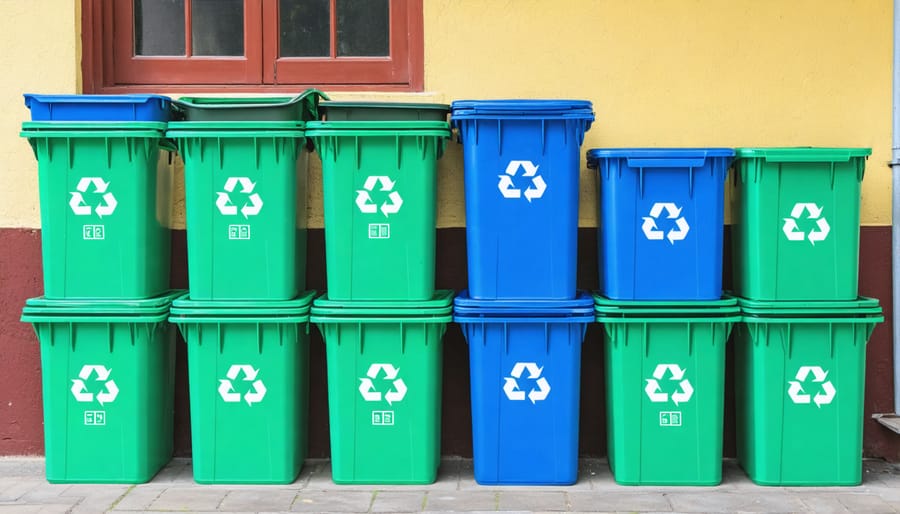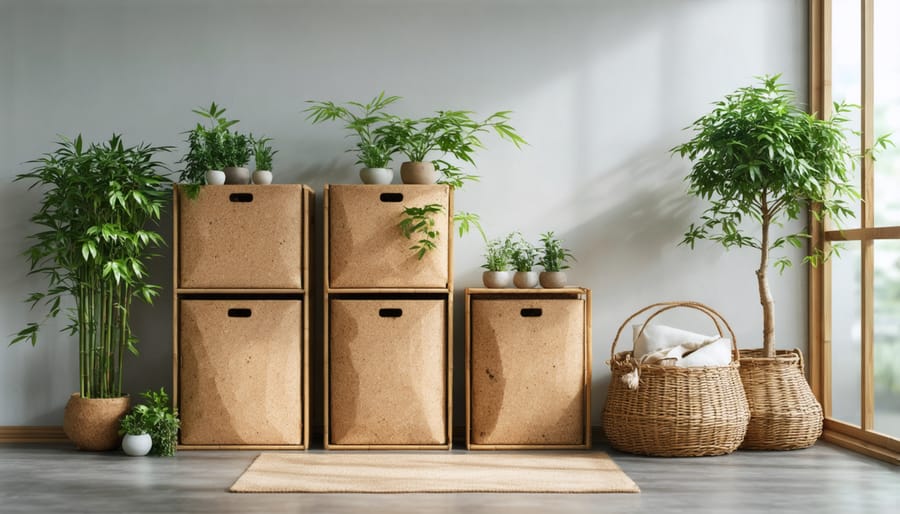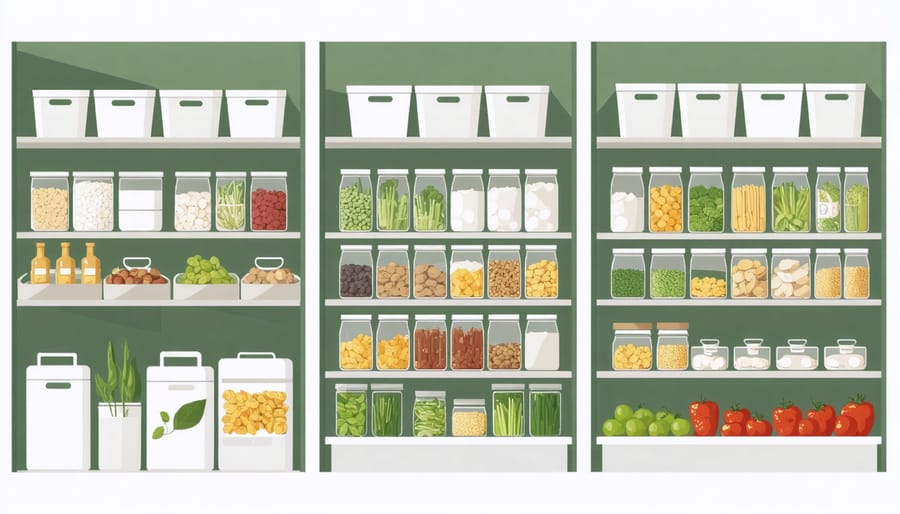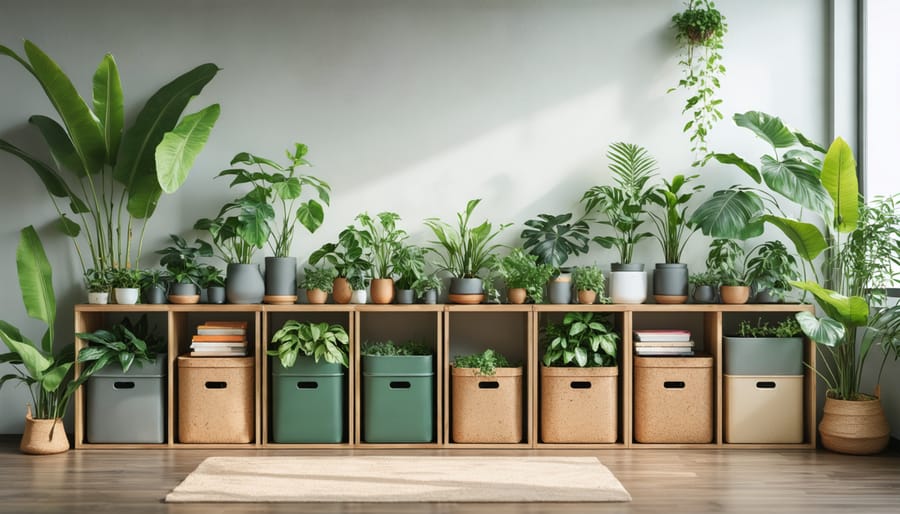Transform your living space with eco-friendly storage bins that protect both your belongings and our planet. Today’s innovative sustainable storage solutions combine biodegradable materials like bamboo fiber, recycled plastic, and organic cotton with practical design features that make organization effortless. These consciously crafted bins with secure-fitting lids not only reduce plastic waste but also offer superior durability and moisture protection compared to traditional storage options. Whether you’re organizing your pantry, decluttering closets, or storing seasonal items, these earth-friendly containers provide the perfect balance of functionality and environmental responsibility. Their stackable designs maximize space efficiency while minimizing your carbon footprint, making them an intelligent choice for the environmentally conscious homeowner who refuses to compromise on quality or style.
Why Choose Eco-Friendly Storage Bins?
Environmental Benefits
Choosing eco-friendly storage bins with lids makes a meaningful impact on our environment in several ways. These sustainable containers are typically made from recycled materials or biodegradable alternatives to conventional plastics, significantly reducing the demand for new raw materials. Many manufacturers use post-consumer recycled plastics or plant-based materials like bamboo fiber and cornstarch derivatives, which break down naturally without harming the ecosystem.
The production process of eco-friendly storage bins generally requires less energy compared to traditional plastic manufacturing, resulting in a lower carbon footprint. When these bins eventually reach the end of their lifecycle, they can be fully recycled or composted, depending on their materials, creating a closed-loop system that minimizes waste.
Additionally, their durability means they last longer than cheaper alternatives, reducing the frequency of replacement and ultimately keeping more items out of landfills. By choosing these environmentally conscious storage solutions, you’re not just organizing your home – you’re contributing to a healthier planet.
Practical Advantages
Eco-friendly storage bins with lids offer remarkable durability that often surpasses traditional plastic alternatives. Made from sustainable materials like bamboo fiber or recycled plastics, these bins maintain their structural integrity even with daily use. Their versatility shines through various applications, from organizing pantry items to storing seasonal decorations, making them ideal for any room in your home.
These bins prove surprisingly cost-effective in the long run. While the initial investment might be slightly higher than conventional options, their longevity eliminates the need for frequent replacements. Most eco-friendly bins feature sturdy, tight-fitting lids that protect contents from moisture and dust, ensuring your stored items remain in perfect condition. Their stackable design maximizes vertical storage space, helping you make the most of available room while maintaining a clean, organized appearance.
Additionally, many eco-friendly bins are lightweight yet robust, making them easy to transport without sacrificing durability. Their neutral colors and sleek designs complement any decor style, proving that sustainable choices can be both practical and aesthetically pleasing.
Top Sustainable Materials in Storage Solutions
Recycled Plastic Options
Recycled plastic storage bins represent a significant step forward in eco-friendly home organization. These bins are typically made from post-consumer plastics like water bottles and food containers, giving new life to materials that might otherwise end up in landfills. The recycling process transforms these plastics into durable, high-quality storage solutions that are just as sturdy as their conventional counterparts.
Many recycled plastic bins feature a satisfying blend of sustainability and practicality. They’re resistant to moisture, won’t rust or corrode, and can withstand temperature changes without warping. Plus, choosing recycled plastic options helps reduce the demand for new plastic production, which means less environmental impact and a smaller carbon footprint for your home organization projects.
Look for bins with clear recycled content labeling – the best options typically contain 50% or more post-consumer recycled materials. Some manufacturers even create bins made from 100% recycled plastic, offering the ultimate in eco-conscious storage. These bins often come in various colors and styles, proving that sustainable choices don’t mean compromising on aesthetics or functionality.

Natural Material Alternatives
When it comes to natural alternatives for storage, bamboo leads the pack with its remarkable sustainability and durability. These bins offer a beautiful wood-grain appearance while being naturally resistant to moisture and mold. Bamboo storage solutions are lightweight yet sturdy, making them perfect for everyday use in any room of your home.
Cork storage bins present another excellent eco-friendly option. Harvested from the bark of cork oak trees without harming them, cork bins are naturally antimicrobial and water-resistant. They’re also surprisingly flexible and can withstand regular handling while maintaining their shape.
Other sustainable materials gaining popularity include seagrass and water hyacinth. These rapidly renewable plants are woven into sturdy storage bins that bring a natural, rustic charm to your space. They’re particularly well-suited for storing linens, toys, and seasonal items.
For those seeking maximum durability, reclaimed wood storage boxes offer both environmental benefits and long-lasting performance. These pieces often come with interesting backstories and unique character marks, making them conversation starters while serving their practical purpose.

Biodegradable Solutions
For those committed to a zero-waste lifestyle, biodegradable storage solutions offer an excellent alternative to traditional plastic bins. These eco-conscious options are typically made from materials like bamboo fiber, cornstarch-based plastics, or recycled cardboard with natural wax coatings. While they might have a shorter lifespan than conventional storage bins, they completely break down in industrial composting facilities, leaving no harmful residues behind.
Many biodegradable bins now come with secure, snap-tight lids and are surprisingly durable for daily use. They’re perfect for storing dry goods, seasonal items, or garden supplies. Some popular options include wheat straw containers, which offer natural moisture resistance, and mushroom-based packaging materials that double as storage solutions. Remember that while these bins are compostable, they should be kept in dry areas to maintain their structural integrity and maximize their useful life.
Smart Storage Tips for Eco-Friendly Bins
Organization Strategies
To effectively maximize storage space with eco-friendly bins, start by categorizing items by frequency of use. Place daily essentials in easily accessible locations and seasonal items towards the back. Consider implementing a color-coding system using naturally dyed labels or markers to quickly identify contents.
Stack similar-sized bins vertically to utilize vertical space efficiently. Most eco-friendly bins are designed with sturdy materials that support stacking without compromising structural integrity. Leave a small gap between stacks for proper airflow and easy access.
Create zones based on room or purpose – kitchen items in one area, craft supplies in another. This systematic approach prevents overbuying and reduces waste. Label each bin clearly using sustainable materials like bamboo tags or recycled paper labels.
For smaller items, use dividers made from recyclable materials inside larger bins. This prevents items from getting lost and maintains organization. Consider using modular systems where bins can be rearranged as needs change.
Remember to regularly audit contents and donate unused items, maintaining the eco-friendly spirit of your storage solution. Keep frequently used items at eye level and heavier bins on lower shelves to ensure safe, practical access while preserving the longevity of your sustainable storage system.

Maintenance and Care
Proper care of your eco-friendly storage bins ensures they remain functional and sustainable for years to come. Start by regularly cleaning your bins with a mixture of warm water and mild, eco-friendly soap. Avoid harsh chemicals that could damage the sustainable materials or leave harmful residues. Gently wipe both the interior and exterior surfaces, paying special attention to the lid seal to maintain its effectiveness.
When it comes to maintaining storage containers, proper drying is crucial. After cleaning, thoroughly dry all surfaces to prevent mold and mildew growth, which can compromise both the bin’s integrity and your stored items. Store bins in a temperature-controlled environment when possible, as extreme temperatures can affect certain eco-friendly materials.
Inspect the lids regularly for proper sealing and any signs of wear. Most sustainable bins feature replaceable seals, which should be changed when they show degradation. For bins stored outdoors, consider placing them under shelter to protect from direct sunlight and harsh weather, which can accelerate material breakdown.
If your bins develop minor scratches, many eco-friendly materials can be restored using natural oils or eco-conscious polishing compounds. For storage bins made from bamboo or other natural materials, occasional conditioning with food-grade mineral oil can help maintain their appearance and durability while preventing splitting or cracking.
Making the Switch: Implementation Guide
Transitioning to eco-friendly storage solutions doesn’t have to be overwhelming. Start by assessing your current storage needs and identifying which bins need replacing first. Focus on high-use areas like your kitchen, garage, or playroom to make the most immediate impact.
Begin with a simple inventory:
1. Sort through existing bins and note which ones need replacement
2. Measure spaces where new bins will go
3. List specific storage requirements (moisture resistance, stackability, etc.)
When ready to make the switch, consider implementing these changes gradually:
Phase 1 (Week 1-2):
– Replace kitchen storage bins first
– Start with pantry organization
– Label new bins clearly
Phase 2 (Week 3-4):
– Tackle bathroom and cleaning supply storage
– Switch out garage containers
– Update basement storage
Phase 3 (Week 5-6):
– Address seasonal storage needs
– Replace outdoor storage solutions
– Organize craft supplies and tools
Remember to properly clean and dry your new eco-friendly bins before use. Consider donating usable conventional storage bins to local organizations rather than disposing of them. As you make the transition, create a system for maintaining your new sustainable storage solutions, including regular cleaning and inspection for any wear and tear.
For best results, involve family members in the process and establish clear organization guidelines to ensure everyone understands the new system.
Making the switch to eco-friendly storage bins with lids is a meaningful step toward a more sustainable home organization system. By choosing bins made from recycled materials, bamboo, or other environmentally conscious options, you’re not just organizing your space – you’re contributing to a healthier planet. Remember to look for durable construction, properly fitting lids, and materials that align with your environmental values. Whether you’re storing seasonal items, organizing your pantry, or decluttering your garage, there’s an eco-friendly storage solution that fits your needs. Take pride in knowing that your organization choices are helping reduce plastic waste and supporting sustainable manufacturing practices. Start small by replacing one or two conventional bins, and gradually transition to a fully eco-conscious storage system that works for both your lifestyle and the environment.





Leave a Reply